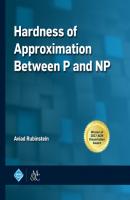Hardness of Approximation Between P and NP. Aviad Rubinstein
Чтение книги онлайн.

Читать онлайн книгу Hardness of Approximation Between P and NP - Aviad Rubinstein страница 22
Название: Hardness of Approximation Between P and NP
Автор: Aviad Rubinstein
Издательство: Ingram
Жанр: Программы
Серия: ACM Books
isbn: 9781947487222
isbn:
Finally, the first component of Bob’s utility is given by:
where the function
3.5.4.2 Analysis of Game
In this subsection, we prove the reduction from SIMULATION END-OF-THE-LINE to finding an ϵ4-ANE. The proof proceeds via a sequence of lemmas that establish the structure of any ϵ4-ANE.
Lemma 3.3
In every ϵ4-ANE
Proof We denote
Since the variance of the yi’s, as well as that of
where [·]ϵ denotes the rounding to the closest ϵ integer multiplication. x* yields a payoff of at least
Note that in every ϵ4-ANE Alice assigns a probability of at most 1 − ϵ2 to actions that are ϵ2-far from optimal. By Equation (3.2) this implies that the probability that Alice choosing a vector x that satisfies
■
Lemma 3.4
In every ϵ4-ANE
with probability of at least 1 − O(ϵ4) (where the probability is taken over
Proof
By Lemma 3.3 and the triangle inequality, with probability of at least 1 − ϵ2, the first m-tuple of x is O(h)-close to E(v). Rounding to Rv(x) ∈ {0, 1}m can at most double the distance to E(v) in each coordinate. Therefore, the Hamming distance of Rv(x) and E(v) is O(h). Hence Rv(x) is correctly decoded as Dv(x) = v, with probability of at least 1 − ϵ2.
Since
■
A similar lemma holds for the second m-tuple of x and the vertex w:
Lemma 3.5
In every ϵ4-ANE
with probability of at least 1 − O(ϵ4) (where the probability is taken over
Since Alice receives the correct vB and βB, we also have:
Lemma 3.6
In every ϵ4-ANE
with probability 1 − O(ϵ4) (where the probability is taken over
Proof
Follows immediately from Lemma 3.4 and the fact that